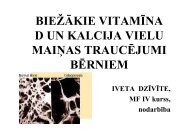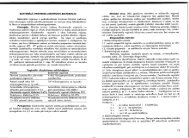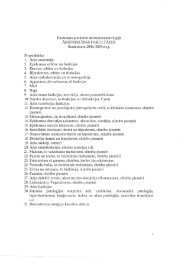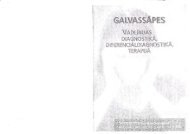PHYSICS
n - susliks.lv
n - susliks.lv
- No tags were found...
You also want an ePaper? Increase the reach of your titles
YUMPU automatically turns print PDFs into web optimized ePapers that Google loves.
stun prey. The strong current is used almost exclusively as a<br />
weapon to attack prey.<br />
17.2. ELECTROTHERAPY<br />
Electrotherapy is the treatment of medical disorders using<br />
electrical methods - in particular, electrodes or instruments that<br />
apply some sort of electrical field, current or impulses to the<br />
body. There are several different electrotherapy techniques.<br />
17.2.1. Methods of Electrotherapy<br />
Iontophoresis is the ion transfer of topical solutions into the<br />
epidermis and mucous membranes using continuous direct current<br />
through electrodes applied to the body. This medical technology<br />
can be used for treatment of edema, skin ulcers, pain,<br />
inflammation, tendonis-bursitis-arthritis, fungus, calcium<br />
deposits and scar tissue. Iontophoresis can also be used to study<br />
neurotransmitters in the brain through the application of<br />
experimental solutions to the tissue using fine glass electrodes.<br />
Transcutaneous Electrical Nerve Stimulation (TENS) Therapy is a<br />
method used for pain relief. In TENS therapy, electrodes are<br />
placed on the skin, either directly over the painful area or more<br />
commonly at key points along the nerve pathway. A small, battery-powered<br />
generator emits a milliampere of electricity through<br />
lead wires to the electrodes.<br />
Galvanic current is a constant and direct current having opposite<br />
poles - positive (anode) and negative (cathode). The positive<br />
pole has an acidic reaction - soothes nerves, decreases blood<br />
supply and hardens tissues. It may be used to make flabby skin<br />
and tissues firmer, to close skin pores after a facial treatment, to<br />
decrease redness as in mild acne, and to prevent inflammation.<br />
The negative pole has an alkaline reaction - it irritates nerves,<br />
increases blood supply and softens tissues. This pole may be used<br />
to remove superfluous hair by electrolysis, to force bleaching solution<br />
into skin and to stimulate the circulation and nutrition of<br />
dry, pale skin and scalp.<br />
Faradic current is an alternating and interrupted current capable<br />
of producing a mechanical reaction without a chemical effect.<br />
128<br />
When a faradic current is applied to the body, the muscles are<br />
toned and the circulation of blood improved. It stimulates hair<br />
growth and increases glandular activity. Faradic current may be<br />
used during facial mani pulations, but it cannot be used for pain<br />
or discomfort, high blood pressure, broken capillaries or a pustular<br />
condition of the skin.<br />
17.2.2. Physiological Effects of Electricity<br />
Electricity has at least three major effects that may be undesirable<br />
- electrolysis, heating and neuromuscular stimulation.<br />
Electrolysis is the movement of ions in opposite directions<br />
through a medium. Electrolysis takes place when a direct current is<br />
passed through any medium which contains free ions. If two<br />
electrodes are placed on the skin, and a direct current of 100 mA<br />
is passed beneath them for a few minutes, small ulcers will be<br />
formed beneath electrodes. These ulcers can be painful and take a<br />
very long time to heal.<br />
Thermal Heating. When an electric current passes through any<br />
substance having resistance (R), heat is produced. The amount of<br />
heat depends on the power dissipated (Q = PR). High-frequency<br />
electric currents are responsible for heating. The local effect of<br />
heating depends on the tissue, the length of time it is heated, the<br />
contact area and the blood flow. Electrical burns often produce<br />
their most marked effects near the skin. Burns have been<br />
produced by a current density of only 5 rnA/mm 2 for 10 s.<br />
Neuromuscular Stimulation is potentially the most dangerous<br />
physiological effect of electricity, in that the nervous system controls<br />
both the circulation of the blood and respiration. Because<br />
the body is a good conductor of electricity and our nerves and<br />
muscles function electrically, physiological effects occur when a<br />
current is applied to the body. If a current of sufficient amplitude<br />
is passed between a pair of surface electrodes, the muscles will<br />
contract because a stimulus is being introduced to the nerve<br />
fibers, which control the muscles. The prolonged involuntary contraction<br />
of muscles caused by an external electrical stimulus is<br />
called tetanus. Prolonged tetanus of the muscles between the ribs<br />
(intercostal muscles) can prevent breathing; tetanus of the heart<br />
musculature prevents blood being pumping out of the heart.<br />
129






